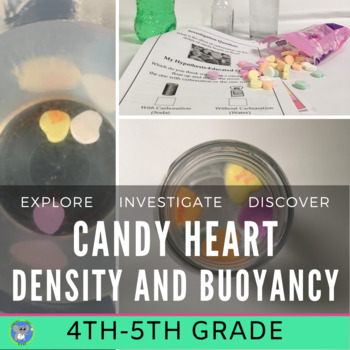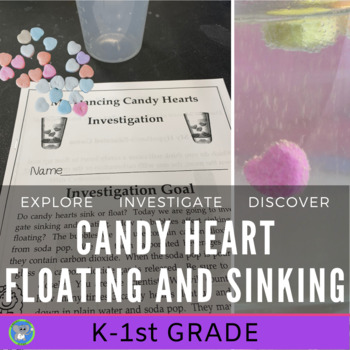Dancing Candy Hearts Valentine's Day Science Activity- Floating, Sinking, and Buoyancy
Life jackets are very important. They keep us afloat and our faces out of the water. Do you know how they work? The science behind life jackets is very interesting. In fact, you can perform a fun experiment using candy hearts and soda to explain how life jackets work. This can be done any time of year, but Valentine's Day makes it especially fun for kids. You may also know this experiment as Dancing Raisins. It is the same experiment; we just switched it up with the candy hearts. We use it to teach sinking, floating, and buoyancy.
When the soda is poured in with candy hearts, the carbon dioxide bubbles in the soda are released. The candy heart's rough surface allows the bubbles to stick. More and more bubbles stick to the heart. The heart volume is increasing due to the bubbles. Do the bubbles change the mass? Not much at all. The heart stays at about the same mass but now has a greater volume. This causes the heart's density to decrease. Once the heart contains enough bubbles to make it less dense than the soda, it will rise to the top. It is now buoyant. The liquid actually pushes the heart to the surface. This is called Archimedes’ Principle. It is also known as the buoyancy principle, which states that a submerged object experiences a buoyant force equal to the weight of the displaced fluid. Because the candy heart has a greater volume, it displaces more soda pop, resulting in a greater buoyant force on the candy heart. The surrounding soda pop pushes the candy heart to the surface.
A life jacket follows the same principles. I bet you have all seen or worn arm floaties or life jackets. They work in the same way as candy hearts. The arm floaties act like the bubbles on a candy heart. They increase the child’s volume, but their mass barely changes. The child becomes less dense and floats in the water. The buoyant force acts on the child, pushing him/her toward the surface. The child would sink if we let the air out of the floaties. (Don’t do that.) Fill the floaties with air, and the child will be buoyant again.
Life jackets are made of materials that are less dense than water. Life jackets have a low mass-to-volume ratio. When the swimmer puts on a life jacket, their size increases, but their mass doesn’t change much. The life jacket is designed to create lift, increasing the swimmer's buoyancy. The upward force exerted by the water pushes the swimmer to the surface, just like a candy heart with bubbles. And think, all this can be learned from watching candy hearts dance!
When Valentine's Day comes, and you are thinking of performing a fun science activity, think of dancing candy hearts. The lesson is perfect for taking a simple science concept and expanding it to the real world. Adding an independent and dependent variable makes it perfect for a class science fair project. Students can explore further and even complete a STEM Challenge.
This experiment works best with traditional Brach's or Necco Candy Hearts. You know, the really hard ones. They have become more difficult to find. Necco was sold to another company, and the hearts returned in 2021. YAY! Brach's changed their recipe, but you may still be able to find them. Always test the hearts you are using first. It varies from year to year. I would buy and test several varieties first, or let the kids test them. You can also compare diet to regular soda or different brands of candy hearts. When in doubt, raisins work great.
This hands-on exploration turns your Valentine Science Activity into a comprehensive unit that not only aligns with the curriculum but also actively engages your students.
This experiment works best with traditional Brach's or Necco Candy Hearts. You know, the really hard ones. They have become more difficult to find. Necco was sold to another company, and the hearts returned in 2021. YAY! Brach's changed their recipe, but you may still be able to find them. Always test the hearts you are using first. It varies from year to year. I would buy and test several varieties first, or let the kids test them. You can also compare diet to regular soda or different brands of candy hearts. When in doubt, raisins work great.
SHOP THIS POST








